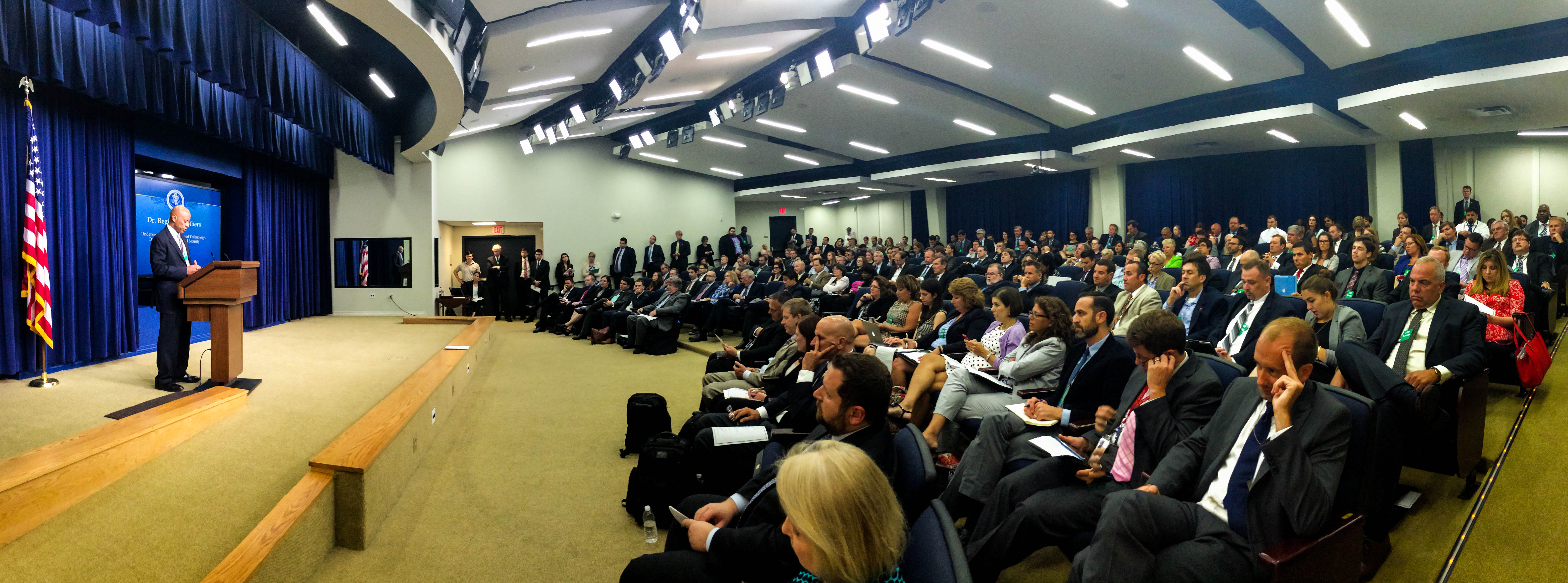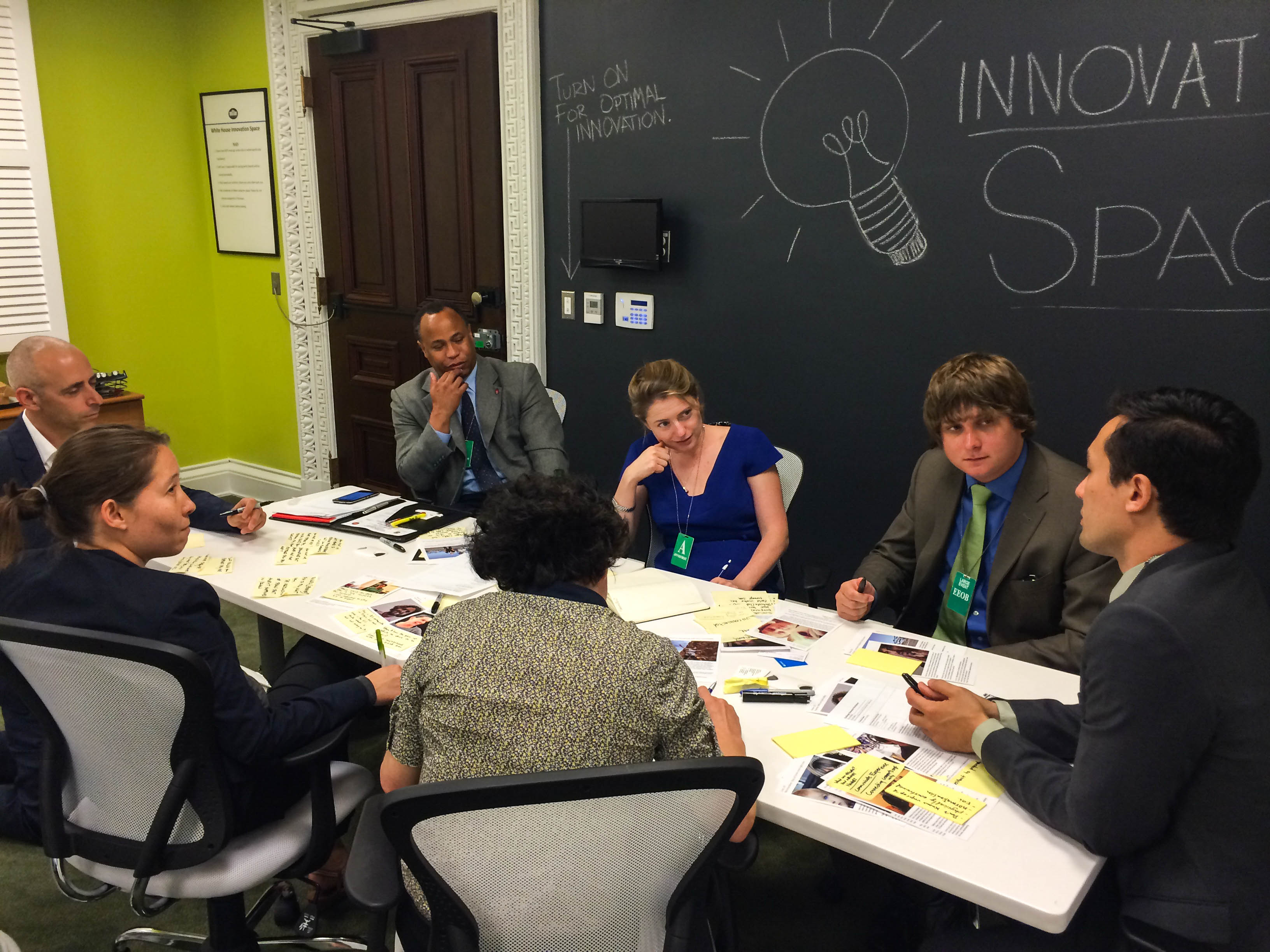
On Tuesday, more than 250 emergency managers, first responders, tech entrepreneurs, and local, state, and Federal officials came to the White House to participate in the Innovation for Disaster Response and Recovery Demo Day. The event was live-streamed to more than 1,250 people interested in leveraging tech and innovation to improve disaster preparedness, response and recovery.
In the morning, participants attended six workshops to identify challenges where open data, social media, predictive analytics, sharing economy platforms, standards, and user-centered design can be applied to improve disaster preparedness, and disaster response and recovery efforts. Innovation facilitators from the Ideation Community of Practice, the global design firm IDEO, and several federal agencies led the workshop participants in drafting challenge statements — such as, “The Homeland Security Enterprise of over 3.5 Million first responders and emergency managers must make difficult decisions in the field to safeguard our nation, often triaging multiple streams of information. How might we provide ‘Social Media, Unplugged’' — a means for response organizations to easily and securely extract emerging insights to better inform and coordinate disaster response?” The challenge statements will continue to be refined over the coming weeks with stakeholder input for inclusion in the upcoming disasters.data.gov site focusing on disaster response and recovery.
In the afternoon, we heard from 20 different companies and local and Federal departments and agencies about ways they are leveraging technology to improve disaster response and recovery. They made extraordinary commitments and gave excellent demos of how their tools could can be used in communities across America and around the world immediately. We’re excited that technology companies, agencies and developers have built powerful tools for the community as a result of this initiative. Examples of highlighted projects stemming from previous White House events and programs included the Appallicious Disaster Assistance and Assessment Dashboard (DAAD) and the Twilio Rapid Response Kit. We were even more excited to hear about the next step — companies working together to develop shared standards, to unlock data that sits siloed in the vaults of company databases, and to improve the usability of datasets.
Below is a sample of the collective efforts announced at the event:
- TaskRabbit is announcing a new mobile web interface, the TaskRabbit “Needs for First Responders,” which provides a safe and efficient marketplace to connect local service providers with those who need assistance. Using the interface, pre-vetted volunteers called “taskers” can respond in real time to posted requests for help from authorized during a disaster.
- Microsoft added the Yammer survivor network to its disaster-response program’s portfolio of rapidly deployable solutions for use in the wake of a disaster. Yammer’s deployment aims to connect and provide a support network for survivors and responders as they recover and rebuild.
- The Weather Company is building a localized alerting platform that will enable state, local, and private authorities to manage and distribute alerts that will go out via The Weather Channel and existing local distribution points, incorporating National Weather Service and existing Integrated Public Alert and Warning System alerts.
- Twilio open-sourced their Rapid Response Kit for developers to stand up effective communications solutions during an emergency response without any telecommunications expertise. The kit delivers nine tools, including SMS-powered volunteer signups and flexible push and pull conference calling, that developers can customize.
- Google extended its Crisis Map, an open source and freely available web mapping tool, to include crowd-sourcing capabilities. Users can now contribute information and updates, such as whether a gas station has fuel available, in the wake of a disaster. In addition, a number of electric utilities and technology companies — including Duke Energy, BGE, ComEd, PECO, SDG&E, Southern California Edison, National Grid, and iFactor Consulting — have agreed to publish power outage and restoration data openly, so Crisis Map and other websites can use and display the information.
- The City of San Francisco and IDEO launched the City72 Toolkit, an open-source, ready-tu-use software package to enable communities to customize and build their own preparedness platforms. Johnson County, Kansas is using the toolkit to launch their own JoCo72 today.
- The Department of Homeland Security (DHS) Science and Technology Directorate, the Feast, and Intel will host a Hardware Hackathon in New York on October 10-11, 2014. The hackathon will bring together hardware-focused innovators to explore what could be created to help make our cities more resilient, and to prototype solutions in a local context in Red Hook, Brooklyn — an area still recovering from the impacts of Hurricane Sandy.
- The Department of Health and Human Services’ (HHS) Office of the Assistant Secretary for Preparedness and Response (ASPR) and Centers for Medicare & Medicaid Services announced the forthcoming launch of an HHS “At-Risk Resiliency Interactive Map.” The open data map will combine the National Oceanic and Atmospheric Administration’s (NOAA) real-time weather-tracking capabilities with data on the number of electricity-dependent Medicare beneficiaries at the U.S. territory, state and county levels to identify areas that may be impacted by severe weather and at risk for prolonged power outages. The HHS “At-Risk Resiliency Interactive Map” is under development and anticipated to launch on www.phe.gov in September 2014.
- The International Association of Emergency Managers and the Big City Emergency Managers made commitments to share the tools presented at the event with emergency managers from cities across America and around the world.
- USAID's Office of U.S. Foreign Disaster Assistance (OFDA) and the Department of State's Humanitarian Information Unit (HIU) announced investments in platforms and tools that promote creation and sharing of open data for emergency managers and disaster vulnerable communities. USAID unveiled enhancements to the OpenStreetMap (OSM)Tasking Manager — an open source mapping tool designed and built to facilitate open data creation and collaborative mapping for humanitarian assistance and disaster response around the world. This effort was carried out in partnership with the Humanitarian OSM Team (HOT), which acts as a bridge between the traditional Humanitarian Responders and the OpenStreetMap community. The Department of State highlighted Map Give, an educational campaign that brings people around the world into the OpenStreetMap community by teaching them about the importance of open map data, giving them the skills to map, and helping them get connected with mapping tasks through a user-friendly website.
For a full list of commitments made on the Demo Day in support of this initiative click here and bookmark http://obamawhitehouse.archives.gov/blog for updates. With National Preparedness Month quickly approaching in September, you can learn more about how to contribute to disaster preparedness by visiting www.ready.gov. We look forward to your continued feedback and encourage organizations to share their progress at disastertech@ostp.gov.
Meredith Lee is AAAS Science and Technology Policy Fellow at the U.S. Department of Homeland Security
Heather King is Director for Preparedness Policy at the National Security Council
Brian Forde is Senior Advisor to the U.S. Chief Technology Officer at the White House Office of Science and Technology Policy



